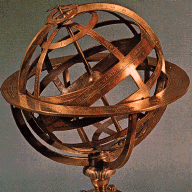An Introduction to Solar System Astronomy
Prof. Richard Pogge, MTWThF 2:30
|
|
Astronomy 161: An Introduction to Solar System Astronomy Prof. Richard Pogge, MTWThF 2:30 |

How the sky appears to us depends upon our location on the Earth, the time of day, and the season of the year. From our vantage point on a moving Earth, the sky appears to turn around us each day. Over the course of a month, the Moon waxes and wanes, changing from a thin crescent to a full disk and then back to a crescent. Over the course of the year the Sun follows a regular path along the Ecliptic that takes it first north, then south of the celestial equator. Finally there are the planets, the "wanderers" that travel near the Ecliptic, but with their own sometimes surprisingly complex motions.
Understanding these motions was not only the first step in learning the place of the Earth in the universe, it also had immense practical importance. Ancient and modern peoples used the regular motions of the Sun, Moon, and Stars to reckon the passage of time and the seasons of the year, giving us our systems of timekeeping and calendars.
In this unit we will examine the apparent daily & annual motions of the Sun, Moon, and stars, the causes of the Four Seasons, discuss the astronomical roots of our conventions for reckoning the passage of time, describe the phases of the Moon and Eclipses, and introduce the Motions of the planets. At each step, the motions we are considering become more complex, and the process of coming to an understanding of that complexity has led us into the modern world.

|
Lecture Audio Podcasts |
See the Astro 161 Digital Movie Gallery for online copies of some of the animations shown during lectures. Beware! These are big files (many Megabytes). You should only try to download them if you are on a fast network link (cable or DSL). These could easily clog a slow dialup connection.